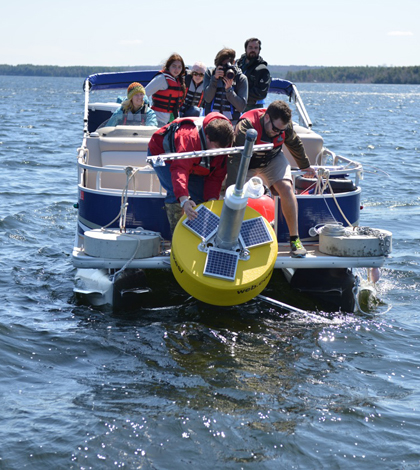Algal Blooms In Great Pond, Long Pond To Be Studied

A crew launches "Goldie," the Great Pond data buoy (Credit: Colby College)
The Belgrade Lakes of Maine are better off than other lakes in terms of their water quality. But algal blooms have become more common in recent years.
To investigate some of the dynamics of those blooms, scientists at Colby College and the Bigelow Laboratory for Ocean Science are sampling in Great Pond and Long Pond this summer. Their work, supported by the University of Maine’s Water Resources Research Institute and the U.S. Geological Survey, will rely on discrete water samples, plankton tow nets and water quality sondes.
Of particular interest to the scientists and undergraduate students involved is a type of cyanobacteria called Gloeotrichia echinulata that forms colonies capable of overwintering in lake sediment. Like other cyanobacteria, its blooms can have negative impacts on water quality and tourism.
“We are continuing monitoring in these two lakes built on many years of citizen science models,” said Denise Bruesewitz, assistant professor of environmental studies at Colby College and leader of the project. She says those models are informed by average people visiting the lakes and reporting back, on a scale from one to five, how bad algal blooms were. Her work will zero in on how the algae use nitrates and ammonium and when they switch to nitrogen fixation to pull nutrients from the atmosphere.

Algal blooms have become a problem for the Belgrade Lakes of Maine in recent years. (Credit: Peachoftree/CC BY-SA 3.0)
To add to those insights, data from a buoy deployed on Great Pond will be considered, as well as analyses of genetic material, chlorophyll concentrations and toxins the algae release. Much of that work will be carried out by Pete Countway at Bigelow and a student assistant.
Each monitoring site will be visited once a week throughout the study period by students collecting samples, and more often if blooms happen. There are some expectations for what scientists will find.
“Based on previous work, also working with Holly Ewing of Bates College, we’ve found some unique patterns even after Gloeotrichia blooms. They still uptake nitrogen,” said Bruesewitz. “The nitrogen story will be important, how they use nitrogen that’s there and then when they switch over to taking it from the atmosphere.”
The investigation is a small-scale, initial foray into the work, says Bruesewitz. After the study finishes up, she and others hope to move forward with a larger-scale investigation in the Belgrade Lakes.
Top image: A crew launches “Goldie,” the Great Pond data buoy (Credit: Colby College)





0 comments